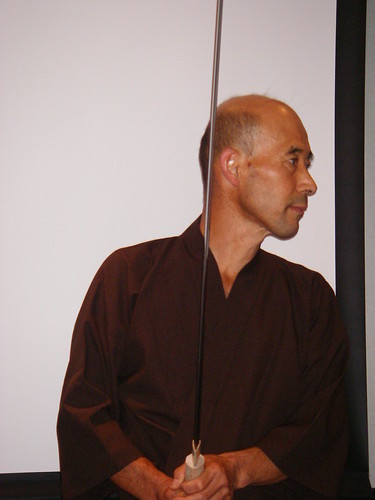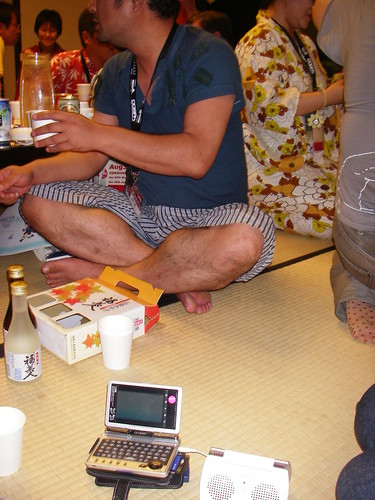Cultural Interlude
31/08/2007 (still)
From cutting-edge deep-sea research to, well, the cutting edge (and deep-seated tradition) of making a katana, or Japanese sword.

This is Sadanaga Kobayashi of Shimane Province, were one of the few remaining traditional forges is located, reviving a two-thousand-year old tradition.
The steel used for making a katana, known as tama-hagane or jewel steel, is of exceptional purity and made from rare native iron-ore. It takes three days and three nights of smelting until almost pure iron is left in the centre of the specially-built tatara furnace. On the fourth day, the tatara is demolished.
The tama-hagane is flattened, broken up and hammered into wafers. The more brittle the pieces, the higher the carbon content and the harder the steel.
At the centre of the katana, there is a core of soft but tough low-carbon steel, known as Shingane which is forged and folded three times. It is surrounded by the much more thoroughly worked Kawagane, the making of which resembles the making of puff-pastry—would the latter require three apprentices hammering down on it in quick succession in order to flatten it between folds.
From Kobayashi Sensei’s quick account and the video that was shown, the process looks straightforward but he did not tell us how many years of dedicated practice it takes to ascend to his level. Instead he talked about the edge of the katana, because the forging is just the basis. The characteristic wavy pattern comes from the yakibatsuchi, or clay paste, which is applied in coats of varying thickness, tapering off towards the edge. The thickness determines the hardening of the blade by varying the time in which it cools when quenched. And if you still think that sounds straightforward, read about it here.
Kobayashi Sensei passed round the Tama-hagane, but not the katana. To handle a katana—even just to hold it—one must have a special licence.
I bet Eddie would have liked for me to bring one home, but not only are these swords rare, they take a week to forge and will set you back at least 10,000 $. He’ll just have to make do with a replica.
However, I wonder what they charge for kitchen knives…
And then came the parties. Ah, the parties…
The most enduring memory most of us will have taken home is that of an overwhelming pong as we stepped out of the lift on the 6th floor of the Intercontinental, Yokohama. It seems the five-star hotel could not fix the aircon on the entire tatami-suite party floor. And of course you couldn’t open the windows.
Double thanks must go to all the party organizers, not only for their unfailing generosity but also for the sheer heroism and stamina displayed in actually hosting the things. For as long as I could take the stuffy air, I had a great time. The parties were not just fun, but also the best opportunity to mix with Japanese fans (there was a big Japanese language program, but relatively few bilingual sessions, which is understandable since the 65th Worldcon was also the 46th Japan Science Fiction Convention).

I found out that I could not sit in zazen for very long.
But more about the parties later.
Tags: events, Japa, Japan without a Clue, NIPPON2007, Travel, Worldcon, Yokohama, Tag Index
June 21st, 2008 at 15:03
I’m interested in history of samurai sword.Emperor of Japan “Tennno” is the last royal prerogative supported by ancient myth in the world.
The Oldest japanese myth literature “Kojiki” says that Imperial treasure sword was got by the god Susanoo from eight head dragon in Izumo.
Raw steel of samurai sword is only made by Hitachi Metals at Yasugi Izumo Shimane prefecture.However Hitachi Metals is famous high-tech steel maker,raw material of formal japanese sword is made by ancient steel making method “Tatara”. Raw steel is called “Tamahagane”(Jewel like steel).
I hear that it is supreme one for sword making.I wanna get and forge it.
January 7th, 2009 at 06:11
In addition,the appreciation of Japanese sword was developed from strength inspection of non-destruction.It is big defference compared to Damascus sword. And wave pattern on sword surface is made not only by forging but also by quenching.
And also beautful wavy pattern is controlled by raw material.So tamahagane is made by ancient steel making “tatara” which high-tech steel maker Hitachi Metals deal with.